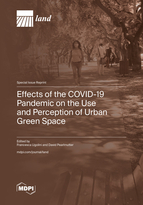Effects of the COVID-19 Pandemic on the Use and Perception of Urban Green Space
A special issue of Land (ISSN 2073-445X). This special issue belongs to the section "Urban Contexts and Urban-Rural Interactions".
Deadline for manuscript submissions: closed (15 August 2022) | Viewed by 51208
Special Issue Editors
Interests: plant-soil relationships; ecosystem services; urban green infrastructure
Special Issues, Collections and Topics in MDPI journals
Interests: urban design; microclimate; green infrastructure
Special Issues, Collections and Topics in MDPI journals
Special Issue Information
Dear Colleagues,
It is well acknowledged how important green spaces are for the provision of various environmental services, as well as social and psychological benefits. In 2020, the pandemic generated by the novel Coronavirus led governments to impose restrictive measures to contain its spread and reduce its dramatic effects on hospitalizations and deaths. Limitations on access to public and private social spaces were applied widely, straining not only national economies but also people's physical and mental health. In the urban environment, the effects of the pandemic are exacerbated. Due to the densely populated landscape of towns and cities, the risk of contagion is greater and vulnerable groups are more isolated from natural landscapes. Urban green spaces represent opportunities to relax and lower the anxiety, but their accessibility is not always good. During the pandemic lockdown, green spaces considered gathering places were closed in some countries, while in other countries it was demonstrated that an urban green space could become an "oasis" for a moment of respite from home confinement. The aim of this Special Issue is to collect studies on the access and perception of green spaces (urban and non-urban) and the natural landscape in general during the time of pandemic, in order to provide governance actors with scientific evidence on which they can base policies for facing and coexisting with dramatic situations such as a pandemic—and for increasing the long-term resilience of the urban and rural landscape.
Dr. Francesca Ugolini
Prof. Dr. David Pearlmutter
Guest Editors
Manuscript Submission Information
Manuscripts should be submitted online at www.mdpi.com by registering and logging in to this website. Once you are registered, click here to go to the submission form. Manuscripts can be submitted until the deadline. All submissions that pass pre-check are peer-reviewed. Accepted papers will be published continuously in the journal (as soon as accepted) and will be listed together on the special issue website. Research articles, review articles as well as short communications are invited. For planned papers, a title and short abstract (about 100 words) can be sent to the Editorial Office for announcement on this website.
Submitted manuscripts should not have been published previously, nor be under consideration for publication elsewhere (except conference proceedings papers). All manuscripts are thoroughly refereed through a single-blind peer-review process. A guide for authors and other relevant information for submission of manuscripts is available on the Instructions for Authors page. Land is an international peer-reviewed open access monthly journal published by MDPI.
Please visit the Instructions for Authors page before submitting a manuscript. The Article Processing Charge (APC) for publication in this open access journal is 2600 CHF (Swiss Francs). Submitted papers should be well formatted and use good English. Authors may use MDPI's English editing service prior to publication or during author revisions.
Keywords
- agriculture
- biodiversity
- gardens
- gathering
- isolation
- mental health
- natural landscape
- nature therapy
- pandemic
- parks
- physical health
- social media
- trees
- urban environment







